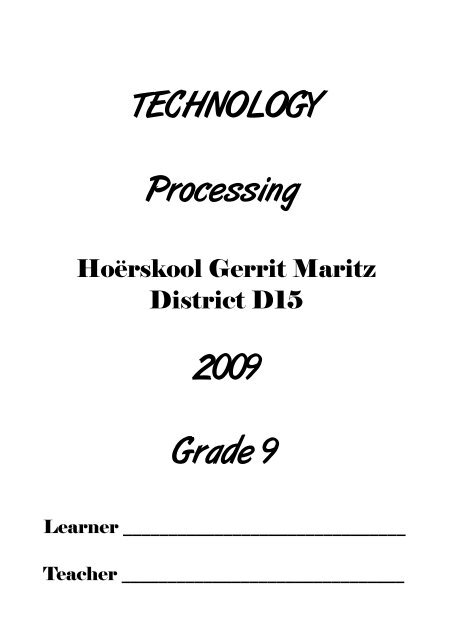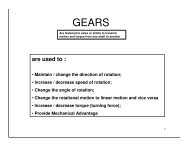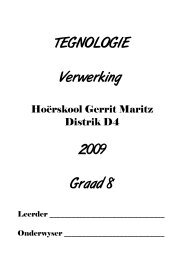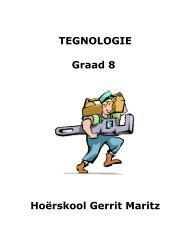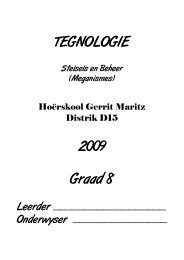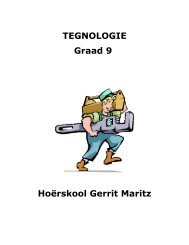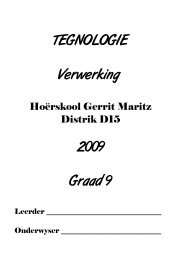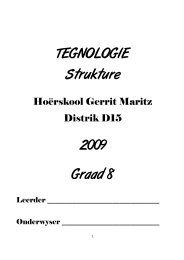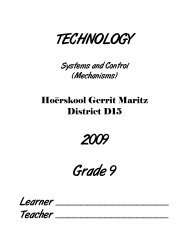TECHNOLOGY Processing 2009 Grade 9 - Tegnologie
TECHNOLOGY Processing 2009 Grade 9 - Tegnologie
TECHNOLOGY Processing 2009 Grade 9 - Tegnologie
You also want an ePaper? Increase the reach of your titles
YUMPU automatically turns print PDFs into web optimized ePapers that Google loves.
<strong>TECHNOLOGY</strong><strong>Processing</strong>Hoërskool Gerrit MaritzDistrict D15<strong>2009</strong><strong>Grade</strong> 9Learner _______________________________Teacher _______________________________
CAPABILITY TASKIt is mid-winter and your friend who lives on the other side of town is very sick. You want totake him/her some hot soup. Because of the distance you can only take your friend food againin two days' time, the soup therefore should stay hot for at least 24 hours.Eskom has reinstated it's loadshedding initiative and your friend has no electricity. Your area haselectricity at the moment so you need to heat up the soup and get it to him/her without it coolingdown.You are going to design and make a container in which you can keep 500 ml to 1 liter of soup hotfor a period of 24 hours.Given specifications:• You may only use found objects and materials to make your insulating container.• You will be working in groups of 2 or 3.• The size of your container may not be bigger than 300 x 300 x 300 mmAt the end of your project (in the space after the drawings for your Final Decision) youhave to write a very detailed explanation of your choices of materials and how yourcontainer will achieve the requirements.Designing and making a container without expaining what you did, why you didit and why it will fulfill the requirements is UNACCEPTABLE.1
INVESTIGATIONPreserving materialsNo substance, from metal to wood to food, will last forever. Many things can cuase substances tospoil, degrade or rot. People use their intelligence to find ways to prevent or slow down spoiling.Preserving is a response to the problem of spoiling. Many food preservation techniques weredeveloped in the era before electricity and refrigeration, for example:Biltong - salted and dried meat first used by the VoortrekkersBokkoms - salted and dried fish by the Cape Malay communityMopane worms - sun-dried by the Venda peopleWe will deal with several methods of preservation in this module, for example: how can wood,metal and food be preserved.WoodWood is an excellent natural product, but it can easily be damaged if not properly cared for.Trees are vital components of the earth's ecosystem and are primarily responsible for convertingcarbon dioxide into oxygen during photosynthesis. When wood is burnt or allowed to rot, theprocess is reversed:Carbon (from the wood) + oxygen (from the air) = CO 2Burning a tree undoes the entire life's work of the treesin only a few hours. Whenever a tree iscut down. at least one indigenous tree should be planted as a replacement.Some exotic (foreign) trees come from wetter climates than ours and are water-wasters. Exotictrees, like the Black Wattle, often invade river and stream banks, reducing the flow of water. Theyshould be removed. The Australian Blue Gum trees tend to be much thirstier than our SouthAfrican indigenous trees. Such trees should be replaced, especially in sensitive areas - like next tofarmlands.When trees are cut down, the wood should be utilised for furniture, school desks and rooftrusses. Only smaller branches and bark should be used as firewood.DeforestationThe forests of the Amazon River in South America and on the islands of Indonesia are being felledat a mind-boggling rate. The high-quality wood is exported to the richer nations of world, andlocal inhabitants reap very few benefits. These trees form the green lungs of our planet.Removing them is causing the quantity of carbon dioxide in the atmosphere to rise, and this is amajor cause of global warming.Remember that tropical forests take sixty years or more to mature. Temperate forests in coolerlands grow more slowly and take twice as long. Parts of Africa are also being looted for timber.The wood is exported outside our continent.Trees are vital for the health of the planet and wood is a valuable commodity. Wood should betreated with respect and protected.Although wood is classified as a renewable resource, trees grow too slowly. Careless or ignorantpeople are cutting trees down at a faster rate than they can be replaced. We must use ourresources in a responsible, intelligent and sustainable way.2
There are a number of important points to remember when protecting wood:The protective material used . . .• should be easily absorbed by the wood• must poison organisms that attack the wood, but be safe for humans and animals.• should be readily obtainable locally• must be cost effectiveThe protective material used should not . . .• reduce the strenth of the wood• cause metals to corrode (rust) for example nails and screws• change or affect the surface of the wood• make the wood more flammablePreserving metalsIron is a metal that rusts easily by combining with oxygen in the air to form various iron oxides.Iron is the most widely used metal in industry, especially if it is alloyed to another metal toimprove its strength or its resistance to corrosion. In 1889 the Eiffel Tower was built in Paris. Thisproved the abilities of iron in construction. It has become the most widely used material in highbuildings.Iron can be painted, chromed, tinned, galvanised with zinc or even rubbed with oil. It can bealloyed with chrome, vanadium, tungsten and titanium.A metal is a substance that conducts electricity and heat well. All metals are shiny - you mayhave to clean off the oxide coating before you see the shine. They are malleable (can be pressedinto shapes) and ductile (can be stretched to form wire). Most metals have high melting points(and even higher boiling points).Copper is used for most electric wire because it is an excellent conductor, and it does not rust(corrode) easily. It is also used for household objects.Gold and platinum are used in industry and jewellery because they do not rust at all. Platinum isused for jewellery and chemical catalysts. Gold is used for jewellery and very thin wires.Other useful metals are aluminium (for cans, aeroplane bodies, cooking foil, pots), iron (for cans,construction, tools, cutlery, steel wire, steel springs, cars, ships, and so on.) and lead (forplumbing).Some metals are alloyed (mixed) with the above-mentioned metals to improve their properties.For example:• stainless steel is an alloy of chrome and iron• tool steel is an alloy of vanadium and iron• tungsten and iron gives a very hard steel for cutting tools and electric light bulb filaments• brass is an alloy of copper and zinc (used for brass door handles, hinges)• bronze is an alloy of tin and copper (used for bronze for statues, machines parts andbearings).We saw earlier that iron rusts easily. Iron can be protected by coating it with paint, or withanother metal that does not rust as easily: tin on iron (tin cans), zinc on iron (galvanised ironroofing sheets, fencing wire, pipes). The protection is very effective if undamaged. Once themetal coating has been damaged, the iron will begin to rust. The rate of the corrosion now willactually be faster than normal for uncoated iron.3
Galvanised ironThe main method of protecting iron from rusting is to coat it with zinc. This is so common thatcorrugated galvanised iron roofing sheets are often called zinc roofing sheets - this is notaccurate since the main metal is iron.There are different methods of coating iron with zinc:Galvanising can be done in several ways:• Electroplating - using electric current to deposit zinc atom by atom.• Hot dip coating - dipping iron into molten zinc.• Sherardizing - covering the iron in zinc dust and baking it on in an oven.• Spraying - applying molten zinc using a fine spray.Zinc is easier and cheaper to apply than chrome, nickel or tin.ElectroplatingThe piece of iron to be coated is placed in a bath containing a zinc salt solution - let us say zincchloride. The iron is connected to the negative pole of the battery. Another piece of pure zinc isconnected to the positive terminal of the battery and placed in the other end of the bath.We need a steady direct current (d.c.) with a low voltage. You will not need more than 6 V to getsatisfactory results. When the current flows through the solution, ions of zinc deposit out of thesolution onto the iron at the `cathode' (the negative electrode).Electrolytic plating can be done with several metals. The shiny chrome on a motorcycle is fixed tothe underlying metal using electrolysis.Before you can electroplate it, the object must be cleaned thoroughly. Wash the objectthoroughly, using an old toothbrush if it has a rough surface. Dip it into an acid solution - vinegarwill do if you leave it long enough. A smooth, polished object will give the best results.Hot dip galvanisingThis fast and effective method is widely used to galvanise iron on a large scale. The key to a goodbond between the iron and the zinc is cleanliness. The process is as follows:• Step 1: Degreasing - the iron is dipped into a hot caustic soda bath. This removes oil, organicmaterials and paint.• Step 2: Pickling - the iron is immersed in acid to remove rust and dirt.• Step 3: Rinsing - the iron is then washed to remove all traces of acid.• Step 4: Heating - the iron is heated to a temperature of 455 °C to 460 °C.• Step 5: Prefluxing - the hot iron is dipped into a solution of zinc ammonium chloride for finalsurface preparation.• Step 6: Spelting - the hot iron is dipped into a bath of molten zinc.• Step 7: Quenching - the hot coated iron is dipped into a zinc chromate solution to cool and tostabilise the surface to prevent early rusting.Preserving foodsFrom the moment a ripe fruit or vegetable is pickled, or an animal is slaughtered for the meat,the food begins to spoil. So we must either use foods that are as fresh as possible, or we msutuse some form of food technology to keep it as fresh as we can, for as long as possible.Why does food degrade?Bacteria, yeasts, moulds and fungi are tiney living 'micro-organisms' that can spoil food veryquickly. Chemical changes caused by enzymes (organic catalysts) soon affect the taste, textureand look of foods. Oxygen from the air may react with chemicals in the food leading to changesof colour, smell and flavour. Animals like insects and rodents cause huge losses in stored foods.4
Food poisoning is most often caused by bacteria like salmonella, botulinum, and Staphylococcus.Food poisoning may occur from one hour or even up to three days after eating contaminatedfood. Symptoms include diarrhoea, nausea and vomiting, pains in the abdomen and fever.The deterioration can be slowed if we create conditions that the causes of degradation do not like.Fungi and bacteria do like warm, moist conditions which make them grow. Heat also speeds upchemical processes. To fight them we just need to provide the cold and dry conditions that theydo not like. In this way we are able to extend the shelf life of many foods.If we cut off the oxygen supply by vacuum packaging or by storing in a sealed container wereduce the bad effects of oxidation. Using insect-proof containers stops the destruction of storedfoods by animals.Food spoilage can be slowed or prevented using physical and/or biological processes:• Physical processes: heating, refrigeration, freezing, drying, curing, canning.• Biological processes: fermenting for example yoghurt, cheese and so on.Using these techniques stops deteriorating caused by bacteria, yeasts, moulds and fungi.In some cases, the preservation is only partially effective. We may need to add chemicals to helpextend the lifespan. Additives that help preserve foods include salt, benzoates and propionic acid.Another approach is to use antioxidants to prevent undesirable changes in colour or flavourcaused by oxygen in the air.CASE STUDY 1Date:_______________________The Nguni grainpitAfter opening the Pit and Ieaving it open longenough a father lowers his son in to the pit tocollect stored grain for use by the family.The Nguni people of South Africa have long hadeffective solution to the problem of storing grain.The sorghum grown in past centuries and themore recent use of maize, is threatened by rats,insects fungi and mould. The Nguni tradition ofstoring grain in claylined grainpits is remarkablyeffective. The grain remains in near-perfectconditionfor many months.anSo, how does it work?The rural people dig a hole, usually in the cattlekraal. The hole is lined with moist clay. When thegrainpit is ready, the sorghum or maize kernelspoured into the pit. A large, f lat stone is placedtop as a lid, and sealed with cow dung mixed with clay. The pit is left undisturbed until the grainis needed. When the pit is opened, it must be left open for some hours because it is not safe toenter at first. The grain is in near perfect condition,except for the kernels that were touching the claysides of the pit. These kernels show signs of havingstarted to ferment but then the fermentation hasstopped.What is the secret science that makes thispreservation process successful?When the pit is completed the clay sides are stillareon5
slightly damp. Grain kernels in contact with the damp clay begin to ferment. The fermentationprocess releases carbon dioxide gas(co 2), a heavy gas that soon fills the sealed grainpit. Thegrain is thus completely surrounded by the CO 2 gas. Without oxygen the fermentation processstops. No insects or rats are able to invade the protective environment of the pit. No aerobicbacteria moulds or fungi can survive inthis CO 2 only atmosphere.Modern grain silos are also at risk from attack by insects, rodents, moulds and fungi. CO 2 gascan be used to replace the air simply by placing a block of dry ice in the top of each silo, andsealing the bottom. Dry ice soon sublimes to form CO 2 gas.Answer the following questions:1. Explain the role of CO 2 gas against insect and rodent attack. (2)_______________________________________________________________________________________________________________________________________________________________________________________________________________2. Why is it dangerous to lower a child into the pit to retrieve grain as soon as it isopened? (2)_______________________________________________________________________________________________________________________________________________________________________________________________________________3. Why did the grain kernels against the sides of the pit start to ferment? (3)_______________________________________________________________________________________________________________________________________________________________________________________________________________4. This indigenous technology is very appropriate for small subsistence storagesystems. How can CO 2 be introduced to prevent damage in modern commercialgrain silo as the one pictured above? (2)_______________________________________________________________________________________________________________________________________________________________________________________________________________5. Present systems diagramsa. To represent the indigenous preservation system used by the Nguni people. (3)b. To represent the more modern preservation system suggested. (3)AssessmentAspectCase Study 1Level 7(Mastered excellently)Answers were logicallyplanned and well structuredand provide in-depthinformationLevel 6(Meritoriouslymastered )Level 5(Substantiallymastered)Answers plannedthat provideinformation to suitthe aim of the taskLevel 4 (Adequatelymastered)Level 3(Moderately mastered)Some answers were given butnot all are applicable to theaim of the taskLevel 2(Elementarymastered)Level 1(Not mastered)Incomplete or couldnot answerquestionsMark___156
Freezing foodsThe Eskimos have been using the natural winter freezing to preserve food for centuries. Mostmeat, fish, vegetables and fruits can be preserved by freezing, but some foods freeze better thanothers. Preserving food by freezing makes it too cold for moulds and bacteria to reproduce, andthis makes it impossible for them to function.Large numbers of our country's people live in poor areas, often without electricity. Many of themhave no way of cooling their raw foods and because of this, food is often spoiled. This makestheir lives even more difficult and hazardous.RESOURCE TASK 1:Date:_______________________Here is an idea for a design of an 'evaporationcooler'. It uses a bottle of water which keeps thehessian wet. This simple set-up can lower thetemperature inside it by as much as 10°C belowthe air outside it.1. Find out how the 'evaporation cooler' works.What is the scientific principle that explainswhy this simple cooler works. (You must usean example to explain this.)_________________________________________________________________________________________________________________________________________________________________________________________________________________________________________________________________________________________________________________________________________________________________________________________________________________________________________________________________________________________________________________________________________________2. Look at the picture and make a list of 5 materials you will need to make an evaporationcooler like this. (5)a. _________________________________ d. __________________________________b. _________________________________ e. __________________________________c. _________________________________AssessmentAspectResourceTask 1Level 7(Mastered excellently)Assignments completedand correct. Obviouseffort.Level 6(Meritoriouslymastered )Level 5(Substantiallymastered)Assignmentscompleted andcorrect. Someeffort.Level 4 (Adequatelymastered)Level 3(Moderately mastered)Assignments completedhaphazardly. Hardly anyeffort.Level 2(Elementarymastered)Level 1(Not mastered)Assignmentsincomplete. Noeffort.Mark___107
If you have access to the internet you might find these webpages useful:http://home.howstuffworks.com/thermos.htmhttp://en.allexperts.com/q/Science-Kids-3250/insulation-1.htmhttp://www.juliantrubin.com/fairprojects/chemistry/insulator.htmlhttp://www.school-for-champions.com/science/thermal_insulation.htmhttp://www.gcsescience.com/pen14-cavity-walls.htmhttp://home.howstuffworks.com/tips-for-insulating-greenhouses.htmCASE STUDY 2Exploring Materials that Minimise Heat LossDate:_______________________Questions:1. What materials would let heat pass through them quickly? (3)__________________________________________________________________________________________________________________________________________2. What materials would not let heat pass through them very quickly? (3)__________________________________________________________________________________________________________________________________________3. Explain what heat insulators and conductors are. Give examples. (6)____________________________________________________________________________________________________________________________________________________________________________________________________________________________________________________________________________________4. Explain the difference between convection and radiation. (6)____________________________________________________________________________________________________________________________________________________________________________________________________________________________________________________________________________________5. How does the thickness of a material affect how quickly heat passes through it? (2)__________________________________________________________________________________________________________________________________________6. What materials are used commercially as insulators? (3)__________________________________________________________________________________________________________________________________________7. What do you think would be a good material for insulation? Why? (2)____________________________________________________________________________________________________________________________________________________________________________________________________________________________________________________________________________________8
AssessmentAspectCase Study 2Level 7(Mastered excellently)Answers were logicallyplanned and well structuredand provide in-depthinformationLevel 6(Meritoriouslymastered )Level 5(Substantiallymastered)Answers plannedthat provideinformation to suitthe aim of the taskLevel 4 (Adequatelymastered)Level 3(Moderately mastered)Some answers were given butnot all are applicable to theaim of the taskLevel 2(Elementarymastered)Level 1(Not mastered)Incomplete or couldnot answerquestionsMark___25RESOURCE TASK 2:Homework Activity: Testing Different Insulation MaterialsDate:_______________________Question 1:Compare 3 bought coolboxes and discuss briefly how each isulates its contents. (5)__________________________________________________________________________________________________________________________________________________________________________________________________________________________________________________________________________________________________________________________________________________________________________________________________________________________________________________________________Question 2: Test the heat insulation qualities of different materials.Equipment:• 5 plastic cups of the same size and thickness.• Ice cubes• A variety of materials to be tested, for example, different fabrics, cotton wool, egg cartonsand other cardboard and paper, bubble wrap (used in packaging), aluminium foil, plasticwrap.• Polystyrene, for example, cups or offcuts from packaging.• Scissors and sticky tape.• watchWhat to do:1. Choose 4 materials to test and insulate your containers with equal thicknesses of each.One is left uninsulated.2. Put the same amount of ice cubes in each cup.3. Check the cups every few hours and count how many ice cubes have not melted.4. Tabulate the results in a graph below. (15)9
AssessmentAspectResourceTask 2Level 7(Masteredexcellently)Assignmentscompleted andcorrect. Obviouseffort.Level 6(Meritoriouslymastered )Level 5(Substantiallymastered)Assignmentscompleted andcorrect. Someeffort.Level 4 (Adequatelymastered)Level 3(Moderately mastered)Assignments completedhaphazardly. Hardly anyeffort.Level 2(Elementarymastered)Level 1(Not mastered)Assignmentsincomplete. Noeffort.Mark___20DESIGNDesign BriefDate:_________________________________________________________________________________________________________________________________________________________________________________________________________________________________________________________________________________________________________________________________________________________________________________________________________AssessmentAspectDesignBriefLevel 7(Mastered excellently)Formulation of problemsolving is clear andcomprehensible.Level 6(Meritoriouslymastered )Level 5(Substantiallymastered)Formulation ofproblem solving isreasonably clearLevel 4(Adequatelymastered)Level 3(Moderatelymastered)Formulation ofproblem solving isvagueLevel 2 (Elementarymastered)Level 1(Not mastered)Formulation of problemsolving is incomplete andnot relevantMark___510
SpesificationsDate:_________________________________________________________________________________________________________________________________________________________________________________________________________________________________________________________________________________________________________________________________________________________________________________________________________________________________________________________________________________________________________________________________________________________________________________________________________________________________________________________________________________________________________________AssessmentAspectLevel 7(Masteredexcellently)Level 6(Meritoriouslymastered )Level 5(Substantiallymastered)Level 4(Adequatelymastered)Level 3(Moderatelymastered)Level 2 (Elementarymastered)Level 1(Not mastered)MarkSpecificationsList of specificationscomplete andrelevant.SpecificationscompleteA few specificationswere givenSpecifications incomplete___5Possible ideasDate:_______________________Make freehand 3-D drawings of 3 possible ideas and briefly give pros and cons for each idea.Pros and cons: __________________________________________________________________________________________________________________________________________________________________________________________________________________________________________________________________________________________11
Pros and cons: __________________________________________________________________________________________________________________________________________________________________________________________________________________________________________________________________________________________Pros and cons: _________________________________________________________________________________________________________________________________________________________________________________________________________________________________________________________________________________________________________________________________________12
AssessmentAspectPossible ideasLevel 7(Masteredexcellently)Ideas very neatlydrawn, labels added.All pros and consmentioned. Chosenidea very wellmotivated.Level 6(Meritoriouslymastered )Level 5(Substantiallymastered)Ideas reasonablyneatly drawn,labels added. Prosand consmentioned.Chosen ideamotivated.Level 4(Adequatelymastered)Level 3(Moderatelymastered)Ideas not neatlydrawn labelsadded. Few prosand consmentioned.Chosen idea notclearly motivated.Level 2 (Elementarymastered)Level 1(Not mastered)Incomprehensibledrawings of ideas. Prosand cons incomplete.Weak motivation ofchosen idea.Mark___10Final DesignDate: _________________________Give final information about your product and make the drawings.__________________________________________________________________________________________________________________________________________________________________________________________________________________________________________________________________________________________________________________________________________________________________________________________________________________Make a first angle orthographic drawing of your product and indicate dimensions.13
Make 3-D drawings of your product. Make use of exploded drawings and labelling to explain youridea in as much detail as possible.Explanation of my choice of materials and why my container complies with the requirements._________________________________________________________________________________________________________________________________________________________________________________________________________________________________________________________________________________________________________________________________________________________________________________________________________________________________________________________________________________________________________________________________________________________________________________________________________________________AssessmentAspectFinal designLevel 7(Masteredexcellently)Working drawing and3-D drawing is doneand labeled.Level 6(Meritoriouslymastered )Level 5(Substantiallymastered)Parts of theworking drawingand 3-D drawinghave been omitted.Level 4(Adequatelymastered)Level 3(Moderatelymastered)Working drawingand 3-D drawingare incomplete.Level 2 (Elementarymastered)Level 1(Not mastered)Working drawing and 3-Ddrawing are neat and islabeled.Mark___1014
MAKEFLOW DIAGRAMDate:_______________________Make a flow diagram to indicate your work progress, tools, equipment and materials in detail.Make a list of your tools, equipment and materials.____________________________________________________________________________________________________________________________________________________________________________________________________________________________________________________________________________________________________________________________________________________________________________________________AssessmentAspectFlowdiagramLevel 7(Masteredexcellently)List of tools andmaterials is detailedFlow diagram islogical andcomprehensible.Level 6(Meritoriouslymastered )Level 5(Substantiallymastered)List of tools andmaterials iscompleteFlow diagram islogical and but abit sketchy.Level 4(Adequatelymastered)Level 3(Moderatelymastered)Level 2 (Elementarymastered)Level 1(Not mastered)List of tools andmaterials is not List of tools and materialsquite complete is incompleteFlow diagram is not Flow diagram islogical orincomprehensible.comprehensible.Mark___1015
ProjectDate: ______________________Paste a photograph of your project here.AspectProjectLevel 7(Masteredexcellently)The container canhold 500 ml to 1liter of soup hot fora period of 24 hours.Only found objectsand materials wereused. Worked ingroups of 2.The size is notbigger than 300 x300 x 300 mmLevel 6(Meritoriouslymastered )Level 5(Substantiallymastered)The container canhold 500 ml to 1 literof soup hot for lessthan 24 hours.Not only foundobjects and materialswere used.Did not work ingroups of 2.The size is too bigor too small.AssessmentLevel 4 (Adequatelymastered)Level 3(Moderately mastered)Level 2 (Elementarymastered)Level 1(Not mastered)All of these:Some of these:The container cannothold 500 ml to 1 liter ofsoup. Stays hot for muchless than 24 hours. Allobjects and materialsused were bought. Didnot work in groups of 2.The size is too big ortoo smallThe container cannothold 500 ml to 1 liter ofsoup. Stays hot formuch less than 24hours. All objects andmaterials used werebought. Did not workin groups of 2.The size is too big ortoo smallMark___3516
EVALUATIONEvaluationDate:_________________________Strong vs Weak points______________________________________________________________________________________________________________________________________________________________________________________________________________________________________________________________________________________________________________________________________________________________________________________________________________________________________________________Possible changes and improvements______________________________________________________________________________________________________________________________________________________________________________________________________________________________________________________________________________________________________________________________________________________________________________________________________________________________________________________AssessmentAspectLevel 7(Masteredexcellently)Level 6(Meritoriouslymastered )Level 5(Substantiallymastered)Level 4 (Adequatelymastered)Level 3(Moderatelymastered)Level 2(Elementarymastered)Level 1(Not mastered)MarkEvaluationRelevant evaluationcriteria. Usefulideas to improveproduct.Reasonableevaluation criteriaand ideas toimprove product.Evaluation criteriaunclear. Ideas toimprove productirrelevant.No evaluation criteria.Ideas to improveproduct incomplete.___10Group EvaluationWrite down the name/s of the members of your group in the table below. Give each member amark out of 10 for cooperation.Name & Surname Mark out 1017


